The High Line is an abandoned railway line in Manhattan. It was built in the early 1930s and has been unused since 1980. It used to transport cattle into the heart of the city. For more than a quarter century, the line was in a state of disrepair, yet the elevated structure was basically sound. Wild grass and plants grew on the abandoned track. During the Giuliani administration, the High Line was set for demolition to make way for development.
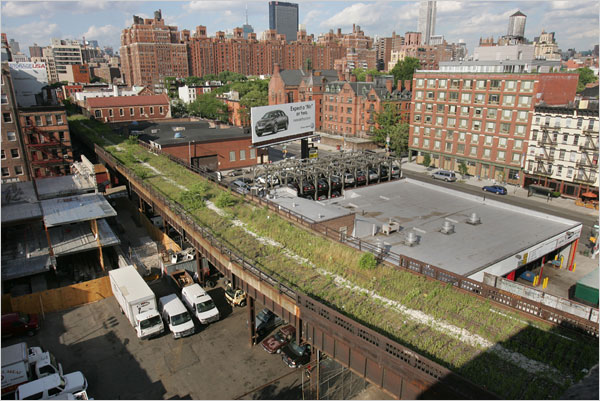
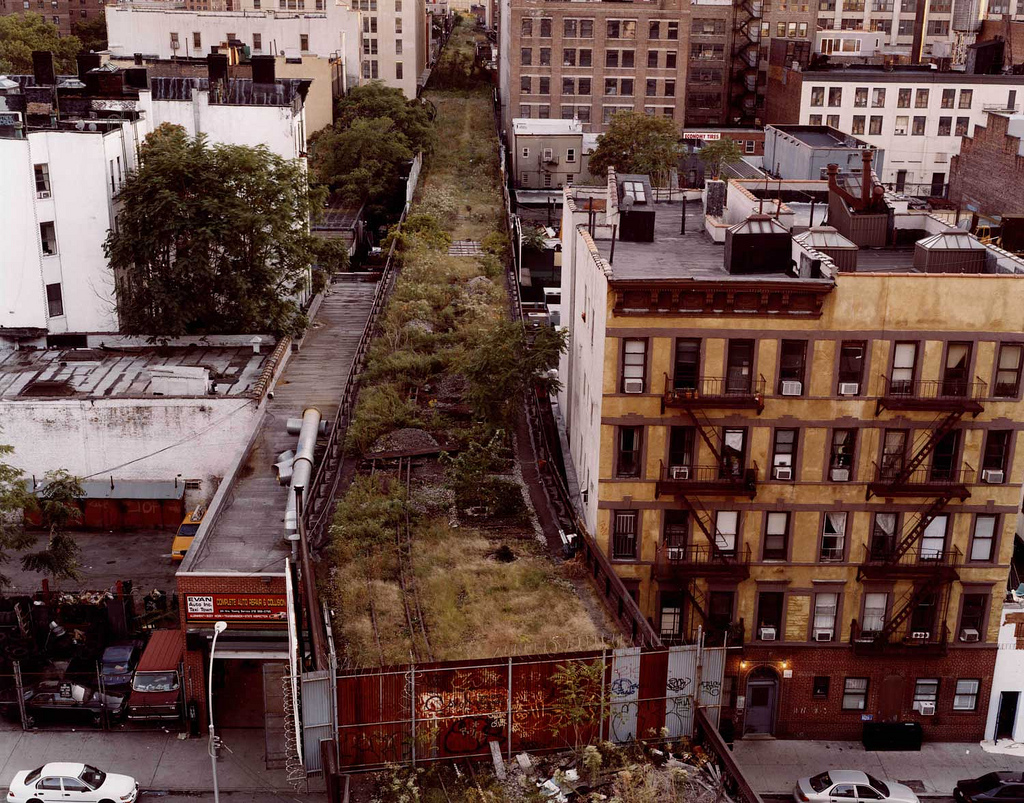
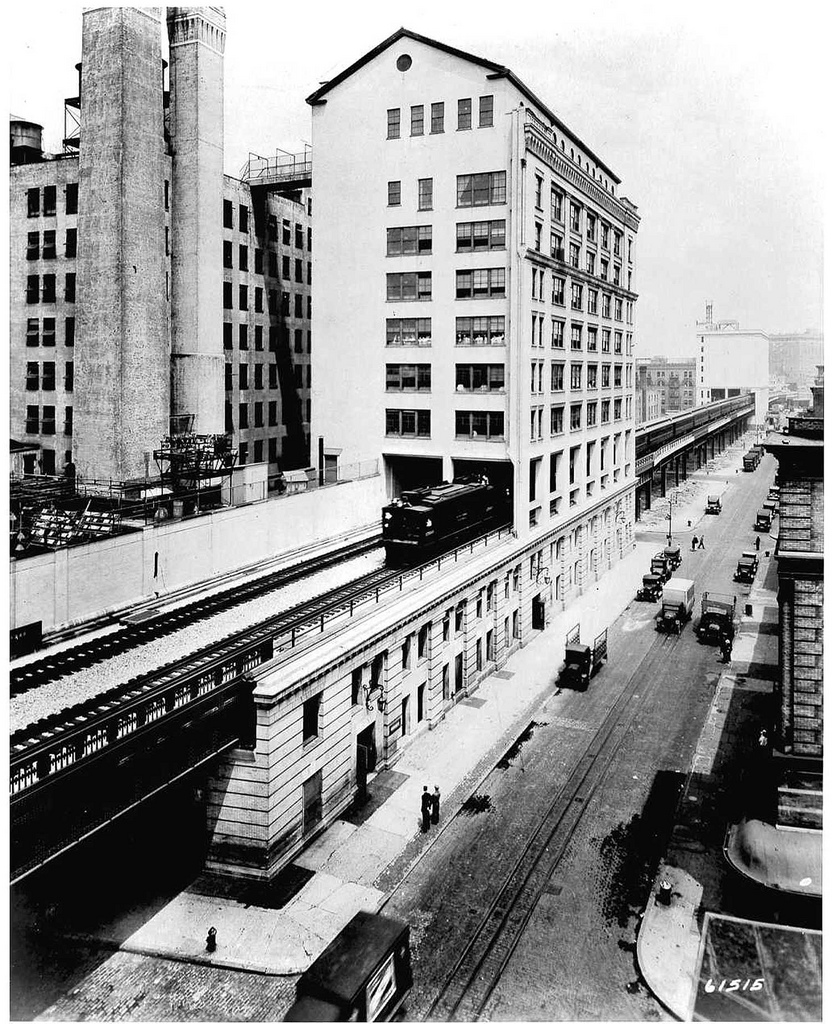
In 1999, neighborhood residents Robert Hammond and Joshua David created a community-based group called Friends of the High Line to try and stop the demolition and transform the High Line into an elevated linear park. They managed to raise more than $30 million dollars to help fund the project, which was used along with funding from the city. The first section of the linear park was opened to the public last Tuesday (June 9th 2009).
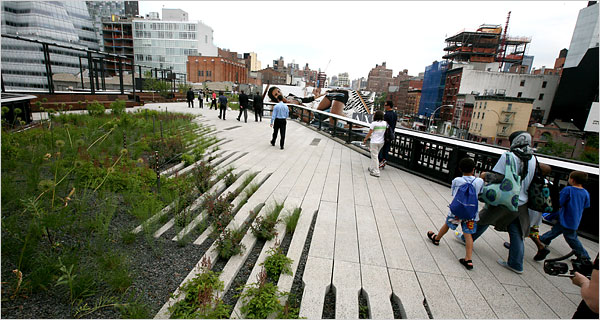
The new High Line is a wonderful example of how we can reuse existing infrastructure and the potential to simply reinvent spaces. The structure was there. People always imagined this possibility occurring, yet for so long it never materialized. It took great perseverance and dedication for the Friends of the High Line to follow through on their ideas and see the project to completion. It is certainly worth the wait.

The project has already reinvigorated its neighborhood. Several hotels and museums have decided to relocate alongside the High Line and will become a part of the experience. Pedestrians now have a wonderful new route that elevates them above the noisy and dirty streets below. The project was designed by landscape firm Field Operations and architects Diller Scofidio + Renfro.
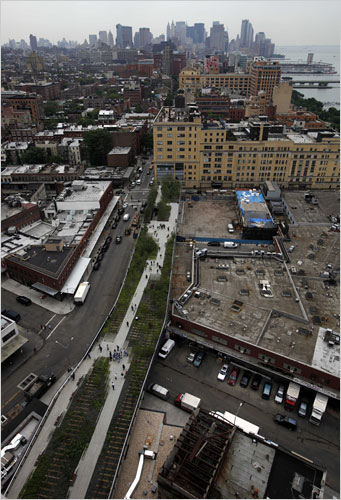
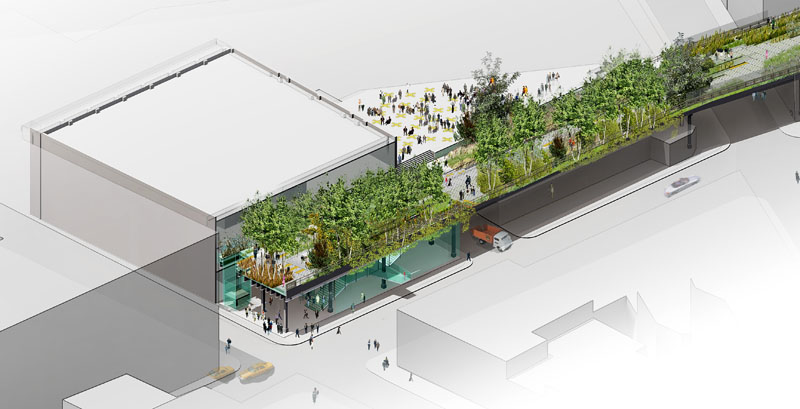
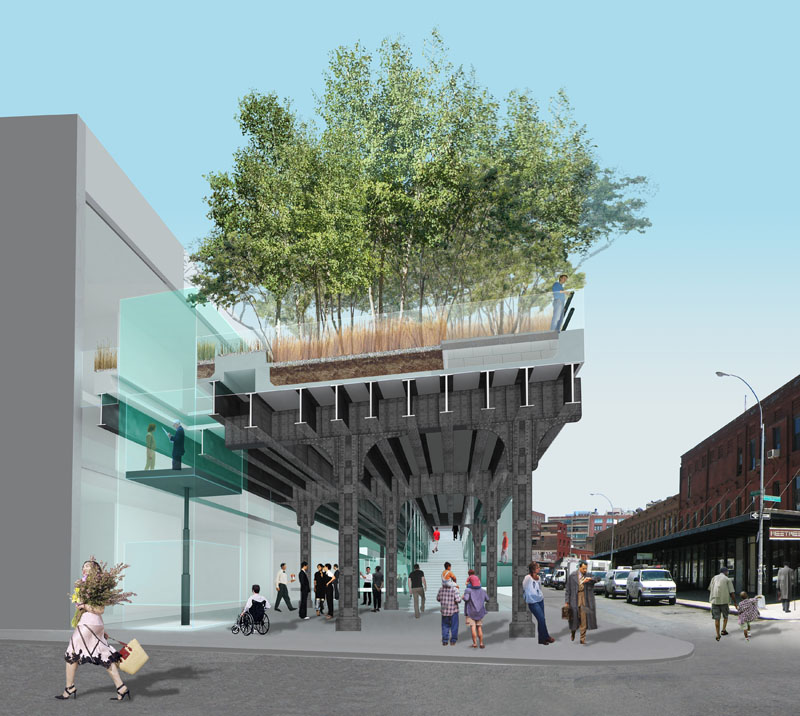
Buildings and infrastructure are static objects, yet the programs that conceived them may have become obsolete long ago. Why should the built environment be held hostage to that original intent? The New High Line transformed the obsolete into the essential. I can imagine the adjacent buildings creating elevated entrances that provide access directly to the park.
Where in Kuwait City can we see the potential for such urban transformation? There are so many possibilities and we here at re:kuwait will attempt to shine the spotlight on such places and visualize how that transformation would take place.
Here are two quick examples of locations in Kuwait City that would benefit immensely from urban renewal. Of course, the obvious candidate is the green belt adjacent to the First Ring Road. This linear space extends from the Sheraton roundabout all the way to the south corner of Dasman Palace. There are only a few buildings on the strip, such as the ice skating rink and the new kids’ education center. The potential here is to create a mixed use park that provides places to jog, to relax and to escape the city (arriving either by walking or car). The financial incentive would be that the land adjacent to the park would become far more desirable and mixed use development would benefit greatly from being built alongside a high-value asset such as a park.

The space is currently vastly underutilized with classically landscaped, badly lit gardens and big open dusty patches. The park would also be only a pedestrian bridge away from the residential areas below the First Ring Road and the redevelopment would provide an excellent ‘mamsha’ for their residents.

Another example for redevelopment in Kuwait is in Salmiya, between the end of the 4th ring road and Salem Al-Mubarak Street (that’s Marina Mall on the top right of the image). As it is, you cannot drive through the space. There is a U-turn at the end of both streets, and the space is lined with parking on either side of the road. A full parking situation would mean that there would be four lines of cars throughout the length of the space. The potential here is to simply remove the streets entirely and have a shaded pedestrian promenade.

The new lively space will be home to street performers, art galleries, small shops owned by young, energetic Kuwaiti entrepreneurs, quirky restaurants and lounge spaces. There is so much demand for space in Kuwait, but most of the available rental space is in hermetically sealed Malls. This is an alternative.
There is ample space for parking in the surrounding lots. The landowners can even charge for parking during high demand. The buildings on either side of the promenade are 30 meters apart, which is wide enough to even allow the shops to extend inwards in places so as to have usable space above the extension. I imagine the end result would look something like this:
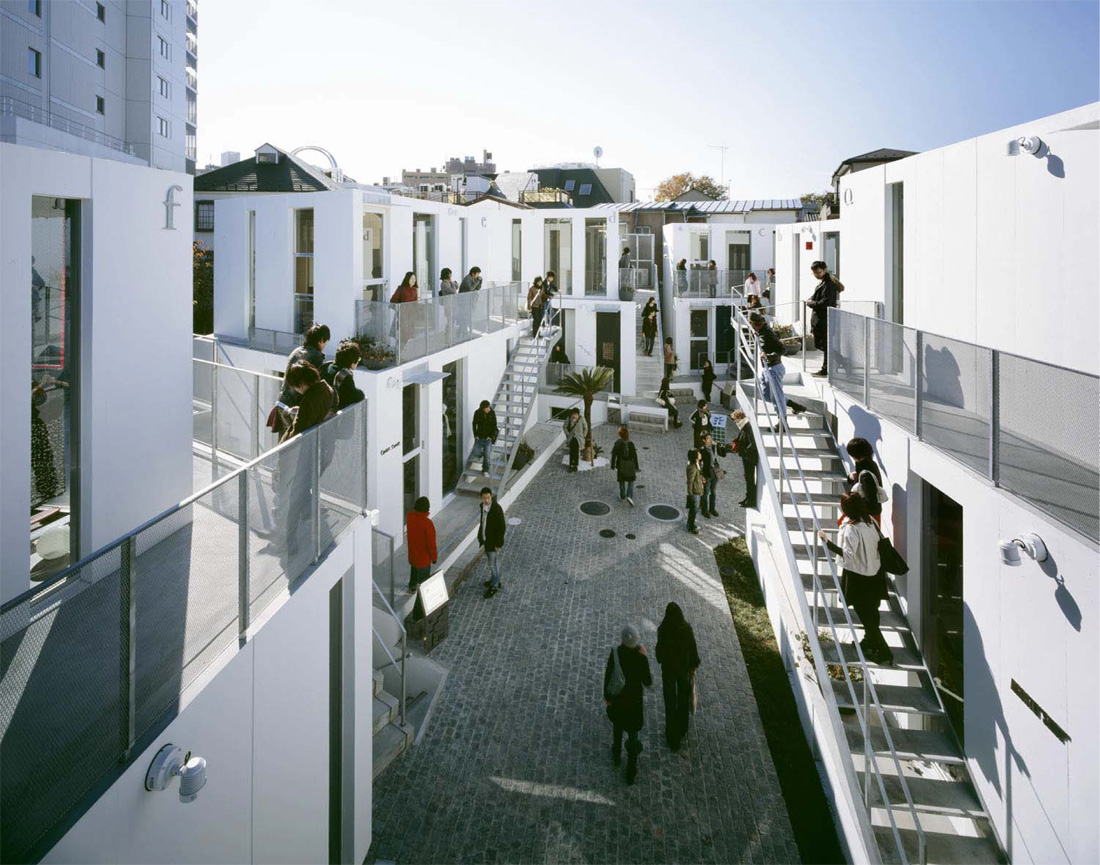
The shops lose by not having direct access to the street, but they would gain far more from increasing the ‘prestige’ of the street and being part of a new and vibrant location. The promenade is accessible to Marina Mall, as it is only one block away.
It’s a shame that nobody has done this yet. The potential is there, yet the space is stagnant and wasted. In future posts we will illustrate and visualize how we believe these projects should manifest. Our hope is that people would be inspired and take the initative to try and make them happen. If two guys in NY city could create a park on an abandoned railway line, we can do so much more.
EDIT:
[youtube=http://www.youtube.com/watch?v=H23jeMWGnbc&hl=en&fs=1&rel=0]
Here’s a video from the Inhabitat where they interviewed the lead design architect James Corner from Field Operations and Ricardo Scofidio from DS+R.

I stumbled by chance onto your blog. Really love it. I’m a big fan of architecture (although I don’t know a lot about), and more so of urban cities. Thank you for giving me an enjoyable daily escape into this amazing world. Kuwait needs more of you guys. you’re proof that reform is so much more than politics and elections. Thank you and please do keep it up!
I love the High Line… been waiting for it to be complete and they finally opened it this week. But I assure you it took years of bureaucratic nightmares to get it done even in NYC
Onto the “Green Belt”, it’s a shame how one of our arteries has been so neglected, and the dim lighting does actually make it feel a bit sinister and unsafe.. hence people staying away from it in droves. What really kills me is the big ugly red mosque that was built just before the roundabout. Some corrupt jerk at the Baladia approved it knowing fully that with the new expansion the mosque will be inaccessible and would serve nobody. And I also lay blame at the feet of the egomaniac who had it built in his name.
“Old Salmiya” is a mess but it can be saved.. I like your ideas
Salmiya needs attention, The Green belt needs attention and Hawally needs attention.
Salmiya holds, for now at least, the title “downtown”, away from our actual capital city. This is something that needs to be examined.
The Green Belt will be revisited by this blog again, with some proposals.
mashallah your one of the best sites as the material you put is unique !
nice work and all the best inshala
I completely agree with what you’re suggesting, and it would be cool to see these ideas developed further! I was in that part of Salmiya last night, and it was so sad to see all the stores leaving for the new structure that’s coming up. Btw, does anyone know the concept behind it, or even what its going to look like?
You make a great point about reusing existing infrastructure and inserting a new program. There, I think is the root of many of the architectural issues we are facing in Kuwait. There is no real concept of preservation; structures are not maintained properly, shoddy additions are added, and in 25 years its time to demolish and build a new building. However, buildings and structures can adapt and be retooled to house new functions. There is no constant, and the character of the city is changing dramatically every generation.
Aisha, I don’t think the problem is literally that we don’t preserve our buildings (although that should be happening). I think the problem is that we’re not preserving the way we build, and why. Every new house, tower and mall seems to be entirely new (in a very bad way). I don’t see a continuum where the building methods (passive cooling techniques, transition spaces, cultural memory/heritage, etc) have evolved into a Kuwaiti architecture. We have no vernacular anymore. I think this is a far worse crime than letting the actually buildings go to waste or be demolished.
I can never understand why conservative people, who take great care to shield their private lives from any prying eyes, would decide to build houses with giant windows facing the street. They will always end up being covered (or even shuttered) so why make that decision? When you explain that a courtyard solution would be far better for them, they’ll get nostalgic for the past, yet reject the suggestion because ‘the sun is too hot’. Why isn’t our architecture evolving? Why aren’t the weak designs dying and the strong ones surviving? Why the design poverty?
I think the two main factors are our rush to modernity and our fear of the sun.
Almost every client I work with, when I propose any solution, complains about the sun. I can’t tell you how frustrating that is. We actually have a very forgiving climate but it’s only workable if you understand it and you know how to control and manipulate it. I believe this fear of the sun is incredibly damaging to our society. Every generation is being sealed tighter and tighter into colder refrigerators. It’s dangerous because it’s both unhealthy and we miss opportunities to innovate.
Many people equate a product being foreign with it being good, and compare them within a known ‘country scale’. ‘Buy this, it’s German!’ ‘No, don’t buy that it’s Taiwanese’. Yes, but maybe that German company isn’t very good? Its a very reflexive reaction that’s taken a long time to set into our collective psychology. I think it’s paralyzing. People never expect innovation anymore and would settle for any solution as long as it’s ‘The Best’ or the most expensive.
I have to admit, though, that in the past few years I have noticed this mentality starting to change amongst our generation. There are a few green shoots that are growing in the creative landscape, but they are few and very far between. It’s going to take a long time for us to grow a forest.
Barrak, yes the rush to modernity did destroy the vernacular architecture that existed; and the building methods we’re currently following are not helping either. Had the original vernacular been preserved, I’m sure the character of our buildings and city would have been dramatically different. It is a crime, and I can go on lamenting that loss for days on end, but I think it is up to us as architects to work really hard in creating a Kuwaiti vernacular for the 21st century. This is by no means an easy task, and it will take a long time before the seeds come to fruition.
I understand your frustration! At the moment I’m experiencing the same issue with a client of mine as well! But, it seems as though my clients have bigger issues with our ongoing sandstorms than fear of the sun haha!
Off-topic, I actually just discovered your blog two days ago and I’ve enjoyed going through your older entries. I’m glad to see these kind of discussions in the Kuwaiti blogoshpere, where there is a wider audience than just architects usually debating other architects at work, crits, events, etc. Knowledge is power, and hopefully this will empower a lot of people in making thoughtful architectural decisions later.
hello, love your blog! and regarding your topic, well I may agree with you regarding Old Salmiyah although i would be highly sensitive to the “face to face” similar buildings along that street, which makes it the mere quality and potential of that space.
on the other hand i find all developers of the green belt disregard its urban problem, the interesting thing in the high line project is how the line is cutting through buildings, and transforming it into a green walk way inverted its space to integrate instead of separate. but what is the quality of the green belt? it is a neglected area, far from the city center, and inaccessible from the suburbs behind the first ring road. if you see a lively area in any city around the world it is merely because there are people living around and nobody live around this area, even foreign workers live around murqab or sharq, i think the green belt is a “no land” if we identify it. and i’m still wondering how can we develop a no land…. or when, because -urbanely speaking- we can’t just make more streets that are separate from people and ask them to visit.
@Aisha: Thanks a lot, and I hope that you keep reading and being involved in these discussions. You seem very knowledgeable yourself and your presence is very much appreciated.
@Deema: Thanks! Although I’m not sure I understand what you’re suggesting. If you mean that creating something like what I was proposing for that strip in Salmiya would be monotonous and repetitive, then maybe I wasn’t descriptive enough in the post. Any new reinvention of that space would no doubt have to create a sequential series of spaces that are playful, discoverable and unpredictable. There is nothing worse than the monotony and predictable linearity of the old shopping mode in Salmiya. Shop, shop, shop, cross the street, shop shop, cross the street. It’s boring.
I visited the strip in Salmiya yesterday. Removing everything in between the buildings and having a sort of linear park is an extremely viable proposal. The buildings were admittedly further apart than I expected, but maybe that’s a good opportunity too. Instead of building new spaces on either side of the promenade, maybe we can create fragments that emerge from the park, and grow and recede wherever they need to, not on the sides, but from the center. It becomes part of a narrative of spaces that start from one end of the strip, all the way to the other. I also underestimated the length of the site. It is really, really long.
I’ll try to make a quick project out of this and present it on re:kuwait for a crit and discussion.
Any ideas? I would like this to be a collaborative project, so if you have any ideas on how to develop the Salmiya site in the post above, please post them here.
First, This is a very good blog.
Second,
I believe it would be nice to have a concept similar to your proposal on Salem AlMubarak Street, but in the heart of Kuwait city. I imagine it taking the space of what is currently “alshare3 aljadeed”. Thus a pedestrian only area would extend from Safat square to the restaurants area adjacent to Souq AlMubarkiya. Take away all the junk electronic stores, and replace them with cafes and high end shops. Could also be semi covered, similar to Galleria Vittorio Emanuele II in Milan.
http://en.wikipedia.org/wiki/Galleria_Vittorio_Emanuele_II
First, Thanks. The most enjoyable part are the wonderful discussions that emerge.
Second, I agree completely with using the Milan Gallery as a case study. It’s a beautiful space. Great gelato.
I think this kind of shopping/browsing typology is far more effective in Kuwait than the malls. The spatial variety and the elements of discovery and the almost seductive quality of old souq like spaces are completely absent in malls.
Barrak, In literature, a repetitive metaphor is dull and boring, in architecture repetitive forms are dull and boring_ but that doesn’t mean that repetition in theory is substantive, in this site it is a potential stimuli. I’m not saying lets do an echo of what’s there it is definitely not my aim, what i’m saying is that we should perceive the space like a film strip, repetition suggests focus, movement, and a big sense of direction. how can we unfold the definitions of a repetitive space, in simple twists under passive experiments instead of adding or substituting.
office dA suggesting: “from this we can do this”. but your suggestion is leaning more towards: “instead of this, lets do this”. there are already inherited qualities in salem al-mubarak that goes deep in memory, how can we make it really speaks backward and forward; like a film strip? we can’t just give a new label to it. the NYC example is teaching us that we don’t have to completely change the area because it predicts its future within its space.
Deema, I admire your passion, but I think you’re misrepresenting my views. What I was trying to show in this post is that by identifying spaces and structures that have the potential for reinvention and reuse, we can create new spaces and programs without erasing what exists.
In the example of the Salmiya strip, there are several degrees of intervention that can be pursued. Minimal intervention would be to simply remove all the parking and create a pedestrian pavement that stretches the entire length of the space. This would cost very little, and would promote many forms of promenade activity. The most drastic intervention would be to include the buildings in the redevelopment and extend them inwards as well as creating passive cooling elements to create a pleasant microclimate (the potential is there since its a long narrow space, and a wind tunnel effect is already in place). Personally, I would love to include the buildings as part of the project, but that would not be practical for legal and financial reasons. However, I don’t think that simply paving the strip is enough either, since that misses a great opportunity to create an emergent landscape that interacts with the existing streetscape and generates a linear narrative.
I agree with you completely about it being a film strip. Linear spaces lend themselves very well to being designed as a narrative, since you walk along a single path; time.
Wow! I missed quite the discussion today.
I kind of imagined something emerging from the center of the linear space itself and that may even split and diverge. For example, one can morph from a ground surface into a green roof canopy for a street cafe; the other becomes stepped seating, or kiosks or continues as benches within the landscape. The potential here, is this space not only acts as a plaza, but also works as a vertical connector as well, where it can link to some of the rooftops for example, which will now have added value. So, it becomes like a meandering object (that reinforces the linear quality of the space), and can create unexpected opportunities that give visitors a sense of place and memory.
Its a beautiful site with a lot of potential and very beautiful qualities. Its very directional, so I understand Deema’s film strip method. But it is also extremely wide, remove all the cars and you’ll see what I mean. So, I do think some sort of intervention is necessary. Maybe not as dramatic as what I suggested earlier, but there is an opportunity to create a new topography of sorts that can enhance the sites natural qualities.
There’s also a lot of collective memory and moments embedded in this area, which is why any intervention has to be particularly sensitive. Another potential area to explore are the large staircases, that cut between the stores. With the car park gone, I feel there should be something that is responsive to these repeated cuts.
Aisha, I think you’ve got the right idea. I too see it as a sort of emergent landscape that would have all the elements of an active park being embedded within the architectural language. It’s difficult to fuse the language tectonically with the existing buildings, since they’re all so different and, frankly, stupid. It has to be seperate, and hence emerging from the ground. I wonder though if we’re missing a major opportunity.
When I was a kid, being driven to Salmiya for the weekend, that traffic light at the end of the 4th ring road signaled to me that we’ve arrived. The bright neon lights and the HUGE advertising boards acted as the gateway to Salmiya. PANASONIC. We could exploit that memory by exaggerating the effect in a sort of post-modern satire of our consumer culture. Or maybe that’s a bit too cynical.
But that area, where Salem Al-Mubarak street starts, that’s the focal point of the site. It’s a visual catchment area, sort of like a funnel. If we think of the linearity of the site as a narrative, I imagine this end of it would be the loud, rowdy, hectic, bright lights, Times Square sort of space. This would transition inwards and become progressively quieter but with sporadic flashes of activity. I’d suggest the other end terminate by splitting into two threads, one heading towards Marina Mall, and the other in the direction of the new Salmiya Park. The point being that a sort of pedestrian triangle is created where people would walk from one to the other, the urban fabric in between is re-energized.
one side of the strip is surface parking, the other side there are houses and very badly organized spaces as if the strip came in place after the surrounding been developed, which is very different from Las Vegas where the strip started in the beginning.. i guess if there is any interest in you to develop the area it is by looking -as well- at the strip evolution…. as in Kuwait city, it started with streets which are also strips in form… what is the “induction” of a strip or a street? how would it affect and vibrates its surroundings, Las Vegas as an example makes it horrible to imagine, but the smaller scale high line would make it more lovely to imagine..
sorry, but it’s not our fault if the post is stimulating, and if we have no Association to discuss over Architecture in Kuwait 🙂
good day!
@ Deema: I heard rumblings that there was an initiative to start a separate entity for architects (rather than be under the umbrella of the KSE), but I haven’t heard anything since!
You’re absolutely right..scale is a big issue here, and in a way it may make whatever is done on the site fly or flop!
@Barrak: the Salem Al Mubarak intersection is crucial. As it stands now, I don’t think you could much. I get your point about it being the loudest part of the site; but isn’t that the obvious solution? What if it is redesigned, and there are large pedestrian zones? That will alter the way we look at it. What I’m thinking of is what if the roads become pedestrianized, and access for cars might be through a tunnel for example? Or at least find a way to minimize how large that intersection is for vehicles; and continue passive cooling elements and effectively link the two areas. The way it is now you don’t really have much of a walkway.
I like the humour in your post modern satire of consumer culture. You know what I’m always reminded of when I’m in that area? The giant Hershey! It was one of my favourite examples of Pop Art in Kuwait! I love the fact that it was just sitting there, you know? It would have been great if every month its surface was turned into a new canvas and people just walk up and work on it according to this month’s theme or concept; so each month would be like a new installation!
Just a minor fix, you mentioned in your post “between the end of the 4th ring road and Salem Al-Mubarak Street”. The street you’re talking about is actually the start of Salem Al-Mubarak Street. The street begins at the end of the 4th Ring Road and continues past Sultan Center.
Anyway there has been talk about making the “old” salmiya a no cars zone but that talk has been going around for ages. I have lived on this street for 30 years, I used to live before right on top of A&W’s (same building as the Mercedes dealership) but after the Gulf War I moved to the building across the street, Anjari Complex. So I have seen this street change from what used to be a classy high end street to the trashy and dirty street it is now.
Currently the talk is the owner of Marina Mall has purchased most of the street and will be demolishing it all and building huge malls and office buildings. I don’t know if its true or not but to be honest anything that happens on this street would be better than what it has turned into now. Currently half the street is getting demolished, a quarter is under construction and the rest is just super trash.
Your idea sounds interesting and although I would love to see that happen (without my building getting demolished) I don’t think it would be practical. Although I am not a fan of malls I do understand them. No one wants to go shopping in 50 degrees heat. The weather today is hotter than it was in the 70s and 80s and there is no reason for me to be all icky, sticky and wet while shopping when i can just go to a mall. In the winter though this would be a wonderful thing. I still enjoy walking to Marina Mall when the weather is great and wouldn’t mind walking on a street that isn’t littered with trash and crappy shops.